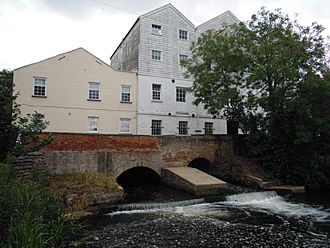Buxton Watermill facts for kids
Quick facts for kids Buxton Watermill |
|
|---|---|

Buxton Watermill elevation.
|
|
| General information | |
| Type | Watermill |
| Location | River Bure |
| Town or city | Buxton with Lammas |
| Country | England |
| Coordinates | 52°45′26″N 1°18′54″E / 52.757125°N 1.315000°E |
| Owner | Private |
Buxton Mill is an old watermill located on the River Bure. It is about 0.5 miles (0.80 km) east of the village of Buxton, Norfolk, in the small area called Lamas, Norfolk. Records show there was a watermill here as far back as the Domesday Book, which was written in 1086. The mill you see today was likely built in 1754 by William Pepper, a local merchant.
Contents
What Does Buxton Mill Look Like?
The current mill building has four floors. It is made of brick and covered with wooden boards called weatherboard. The front side (east) has three main sections with pointed roofs called gables. On the top floor of the middle section, there is a wooden structure called a lucam. This is a covered hoist that was used to lift sacks of grain. It sticks out over the road below.
How the Mill Got Its Power
The River Bure at Buxton was quite wide and flowed with a lot of force. By changing the river's path slightly, the mill could use a drop of 6 to 7 feet in the water level. This gave the mill a lot of power.
Originally, a large water wheel, about sixteen feet tall, was used. This wheel was located in a separate brick building behind the main mill house. It was a breastshot water wheel, meaning the water hit the wheel about halfway up. In 1902, this water wheel was replaced by a turbine. A turbine is a machine with blades that are spun by moving water, similar to how a wind turbine works with air.
There was also a second water wheel. This one was an overshot wheel, where water flowed over the top to make it turn. This water came from the Aylsham Navigation, a waterway, and got its power from a nearby lock system.
The turbine installed in 1902 was smaller and spun much faster than the old water wheels. This meant fewer gears were needed, which saved a lot of power that would otherwise be lost. Even in 1965, this turbine was still providing a quarter of the mill's power needs! It was well-maintained and could have kept running for many more years.
The mill's power was used to turn two or sometimes three pairs of millstones. These heavy stones ground things like animal food. They also produced flour for baking and special flour for making biscuits. Later, electric machines were used to mill biscuit flour.
The Mill House Next Door
Next to the watermill, on its north side, is the Mill House. This house was built in the Georgian style, which was popular in the 18th and early 19th centuries. It has a fancy ironwork porch at the front. The back part of the Mill House was likely added soon after the main house was built. This section used to be a granary, a building for storing grain. It has special wooden supports like corner posts and dragon beams.
A Mill's History
Buxton Mill has a long history. In January 1991, a big fire badly damaged the mill. However, it was carefully rebuilt after the fire. You can find more about the mill's history and its rebuilding on websites like Norfolk Mills.

